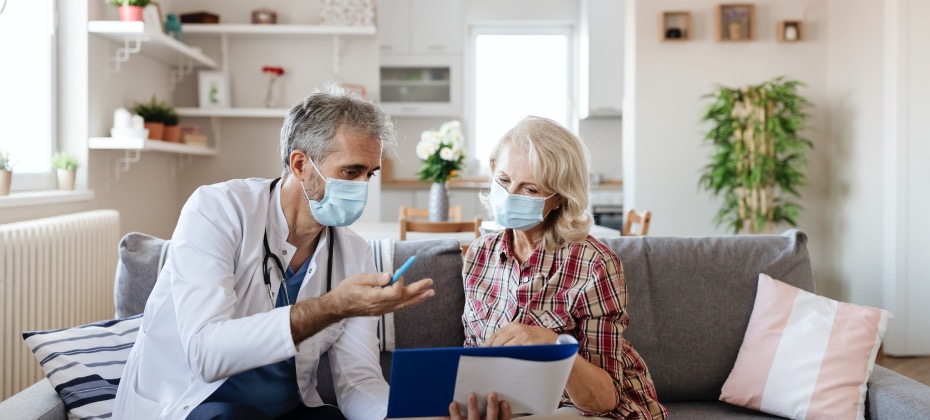Tag: COVID-19

As the country strives to ramp up the pace of COVID-19 vaccinations, providers need to take new approaches to drive registration volume. Healthcare experts are increasingly concerned about the rapid spread of the highly contagious delta variant, which now makes up over 83% of COVID-19 cases. This variant is estimated to be 60% more transmissible than previous strains, and while vaccination doesn’t eliminate the risk, it does reduce the likely severity of infection, which is better for both individuals and health services. Ramping up the vaccination program and ensuring that a large proportion of the population receives the injection just became a lot more urgent. This is also critical for vaccine management plans as the U.S. looks to offer and roll-out booster shoots later this year. The initial vaccine rollout was plagued with issues, many of which remain unresolved. An uneven rollout, confusion over where to get vaccines, and logistical obstacles with preparation, distribution and funding at the state level meant the program got off to a slow start. Consumers were deterred from registering due to inefficient scheduling systems, while others were left frustrated by basic user interface challenges. And for those less familiar with digital technology, the shift to online platforms took some getting used to. Now, with the delta variant taking hold, and vaccine hesitancy on the rise, healthcare providers need to consider how digital technology can make vaccinations more accessible, rather than becoming the obstacle. Improving the user experience through digital tools and automation can reduce barriers to care, drive up vaccine registrations, and ultimately lead to better outcomes for individual and population health. Poor UX creates avoidable barriers to scheduling care One of the major accessibility challenges for consumers was being able to schedule vaccine appointments. In the initial rush to get vaccinated, demand outstripped supply, and online scheduling systems struggled to bear the load. Some providers tried to rely on email booking systems or third-party event schedulers – which resulted in communication errors, delays, missed appointments, and huge burdens on call center staff. For individuals who were unable to use online systems due to limited internet access, disability, or unfamiliarity with the technology (for example, as reported by some older people), the inaccessible and non-intuitive user interfaces created a digital divide. The poor user experience also contributed to some individuals feeling hesitant about seeking the vaccine, eroding their trust in the system as a whole. Efforts to increase and ramp up vaccination rates will be much more successful if the scheduling process is simplified. Frictionless scheduling and registration can drive up vaccine rates With the right data and digital tools, many of these patient access challenges can be resolved. Frictionless self-scheduling and streamlined registration processes can make it easier for people to book appointments and register for the vaccine. For example: Online scheduling platforms allow patients to book and reschedule vaccine appointments whenever and wherever it’s most convenient, as part of a multichannel approach. Automation enables providers to create an outreach list of patients who may be waiting for the vaccine, and send automated reminders by text or email. These can be used to disseminate accurate information to alleviate vaccine hesitancy. The messages can also be personalized to follow the patient’s individual communication preferences. Consumer data and analytics on the social determinants of health can be folded into communications, to tailor information to specific segments of the population who may have been adversely affected by barriers to care. Scheduling software can pull together real-time booking and registration data into a single, holistic view of patient access, whether patients booked via online platforms, call centers or in provider offices. This will help alleviate bottlenecks and make better use of staff resources. Digital tools can improve the patient experience and supercharge vaccine management plans, but only if they are implemented properly. Experian Health’s Director of Product Management, Liz Serie, says, “The old way of doing patient intake involves piles of paper, clipboards and long waits in the waiting room. The new way involves automation, pushing relevant and personalized information to patient’s devices, and seamless data management to initiate the patient journey. It’s a reassuring, simple and reliable user experience, especially as many still need to be vaccinated. And as patient volumes drive back up, investing in a welcoming digital front door is critical.” The future of patient access is digital, and providers that get their systems up and running effectively now will reap the benefits in the long run. Find out more about how data and digital tools can make vaccine appointment scheduling a breeze for your patients and patient access team.

Consumer-led care hit its stride during the pandemic. COVID-19 unlocked healthcare’s digital front door, giving patients more control over how and when they schedule and manage appointments. Unfortunately, while digital patient access has made navigating the healthcare system more convenient and flexible in many ways, consumers are discovering that one of the more frustrating aspects of the healthcare experience has failed to keep pace with scheduling, payments and other digital advances: registration. Waiting rooms. Paperwork. Misplaced insurance cards. Confusing copays. More paperwork! A hassle before the pandemic, registration has become even more challenging for staff and patients in the context of “contactless care.” With more patients starting to come back through the door as a result of vaccination programs and rescheduled elective procedures, there’s an opportunity for providers to smooth out the kinks in the registration experience. Vaccine “hesitancy” has exposed wider issues in patient registration Headlines suggest that large numbers of patients are fearful of being vaccinated against COVID-19. But dig a little deeper, and the issue is more complex. Many patients do want to be vaccinated, but struggle to navigate complicated registration websites, and therefore aren’t showing up for their shot. The Kaiser Family Foundation reported in January that two thirds of patients were unsure of how to access the vaccine. The high volume of patients having trouble getting the information they need is shining a light into the dark corners of the registration process, where improvements have long been needed. Improving the patient registration process isn’t just a pandemic problem While it’s true that COVID-19 is driving the push for online patient registration, improving the overall experience offers wider, longer-term benefits to patients and providers: A convenient and consumer-friendly registration experience Online registration is easier, faster and simpler for patients. With 73% of consumers saying they want to manage their healthcare admin through patient portals, convenient self-service solutions are a trend that’s here to stay. (Find out more about consumer attitudes to patient access in Experian Health’s Patient Access Survey.) More accurate patient data and fewer duplicate records When consumers are the ones responsible for entering their patient information, and when they can do it in a time and place that suits them best, that data is far more likely to be accurate. Not only does this create a better patient intake experience, it also reduces the risk of patient identity errors and duplicate records. With a text-to-mobile registration tool, patients can begin the process with one click, and then easily verify and edit information to make sure their records are up to date and correct. Operational efficiencies and better claims recovery Beyond the customer experience, improved registration can reduce the risk of denied claims, because the data is processed more accurately and quickly, and can be automatically verified against comprehensive datasets. Patients can also choose to pay copay amounts upfront through online registration tools, which makes bad debt far less likely, and improves the overall revenue flow. Safer and smoother registration during flu season COVID-19 put unprecedented pressure on registration processes. But more streamlined systems with remote, mobile-friendly registration tools will make a typical flu season more bearable for patient access staff and patients too. Patients and staff have suffered through cumbersome registration processes for years. Perhaps one unforeseen benefit of the COVID-19 pandemic is that the days of sitting in busy waiting rooms, filling out multiple forms, will be a thing of the past? Discover how Experian Health’s patient intake solutions could help your patient access department create a registration experience that matches today’s consumer expectations.

More than 40% of patients surveyed skipped medical care in the early months of the pandemic, according to a recent study by researchers at the Johns Hopkins Bloomberg School of Public Health. Of those who needed care, 58% missed scheduled preventive care. Similar trends are observed in cancer screening, with appointments for breast, colorectal, and cervical cancers – in some cases dropping by around 80%-90% in March and April 2020, compared to 2019. Diagnostic testing for several cancers also plummeted, as did HPV vaccinations. These trends aren’t unexpected: COVID-19 forced medical facilities to cancel or scale back services, while fear of infection and financial worries kept many patients away. But with most services operating at near-normal capacity again, and the vaccine program tipping the balance in favor of rescheduling care, preventative services are still lagging. Many patients remain reluctant to attend screening and wellness visits, despite the health risks associated with delaying care for potentially serious conditions. Re-establishing a preventive care routine is essential. For patients, getting back on track with earlier diagnosis means more timely treatment and a better chance of recovery. It promises a better financial outlook for patients, payers, and providers alike, who all suffer higher costs when medical conditions escalate. And providers want to get their day-to-day business back on track to smooth out what has been a heavily disrupted workflow and revenue cycle over the last year. Providers must reassure patients that returning to care is safe and necessary. Compassionate and personalized support will be key to making sure patients get the right care at the right time. Automated patient outreach strategies built on comprehensive patient data can help reverse the trends in forgone care. How can data and automation support personalized patient outreach? Kelly E. Anderson, one of the authors of the John Hopkins study, suggests that “physicians can mitigate some of the long-term harmful effects of this forgone care by proactively reaching out to patients who missed care, to try and reschedule the care either in-person or through telehealth.” Automated outreach combined with easy patient scheduling platforms can help providers identify and invite healthcare consumers to get much-needed preventive care appointments back on track. For example: Automation makes scheduling easy for patients and efficient for providers Online scheduling platforms allow patients to reschedule missed appointments at a time and place that suits them. A targeted outreach list of those patients most likely to need screening (for example, based on age, lifestyle, or health risk factors) can be used to send automated booking prompts and reminders by text message or interactive voice response (IVR). It’s simple and convenient for patients and reduces pressure on call center staff. Plus, it generates a wealth of useful real-time data on response rates to pinpoint areas for improvement. With the right data, providers can direct patients to appropriate services For patients that can’t or prefer not to attend their usual healthcare facilities, directing them to telehealth services or alternative venues might be a good option. Similarly, patients with a medical or family history that suggests a higher risk of cancer ought to be prioritized for screening. But you can only do this when you know who those patients are, and what exactly they need. Social determinants of health can be a powerful tool to help providers determine a holistic view of patients’ clinical and non-clinical needs. ConsumerView collates consumer data from over 300 million individuals, across multiple demographic, psychographic and behavioral attributes, so providers know more about the lifestyles and interests to be able to effectively resonate and engage. Data helps create a better patient financial experience Since many patients are worried about the loss of health insurance, outreach efforts might also involve pointing patients towards appropriate financial support. When socio-economic data reveals that a patient is struggling financially, providers can quickly check for missing coverage, offer tailored payment plans, and help obtain charity care if required. Automated outreach can also deliver the upfront information about healthcare pricing that so many patients demand, and help staff collect faster patient payments by providing easy payment links through text and IVR campaigns. Consumer data can inform compassionate patient communications With the majority of patients opting out of scheduled appointments because of concerns about COVID-19 exposure, any invitation to reschedule care should offer plenty of reassurance about hygiene protocols. Some patients may need a gentle nudge to reschedule appointments, so if you can help them feel comfortable visiting facilities and tell them what to expect, they’ll be more likely to return. Offering additional reassurance and support to communities who are traditionally underserved by healthcare services, or who have been harder hit by COVID-19, will be even more important. Best contact information, social determinants of health insight and ethnicity insight can support efforts to promote screening to groups who may face additional barriers to care. With the right data, you can go beyond compassionate messages and choose an appropriate communications channel that’s the right fit for the consumer, too. One thing that hasn’t been hindered by COVID-19 is the trend toward healthcare consumerism. Patients have a choice about which provider they use. Proactively supporting patients to catch up on missed care is a surefire way for providers to stand out as the easy choice.

Product featured in this article: Coverage Discovery As of the end of March 2021, more than 53 million Americans have been fully vaccinated, allowing for cautious optimism as we prepare for the next phase of the COVID-19 journey. Unfortunately for pharmacists, the vaccination program has compounded many of the challenges of the last 12 months. Shots may be free to patients, but someone has to pay for them – and getting reimbursed is proving to be a major pain. Complicated billing processes, extra billing audits and mountains of extra paperwork, rejected claims and slow payments are not exclusive to pharmacies helping vaccinate America. With the coronavirus pandemic continuing to muddy the insurance landscape, getting hold of missing dollars is challenging. Healthcare reimbursements haven’t been straightforward for other providers either: widespread coverage loss and uncompensated care is putting extra strain on hospital revenue cycles. With the coronavirus pandemic continuing to muddy the insurance landscape, getting hold of missing dollars is challenging. Providers must find ways to quickly and accurately determine each patient’s coverage status to minimize bad debt. Navigating the complex world of post-COVID healthcare coverage What does the reimbursement landscape look like, one year on? After a long wait, elective procedures are back. But the surge in patient volumes means providers must be on their toes to keep track of coverage. The process for doing so must be streamlined and precise. Ramping up capacity to verify and check coverage without burdensome paperwork is a must. Patient intake is under pressure. More patients are coming through the doors as a result of elective services and vaccination programs (though not always to their usual facility). COVID-19 hasn’t gone away, and with pockets of infection spikes, safety remains a top priority. Capturing adequate insurance information in this context is no mean feat. Running automated coverage checks as soon as the patient arrives will minimize face-to-face contact during admissions and avoid delays. Patient access and collections staff are overburdened. Manual checks are difficult when staff are operating remotely or in a socially distanced environment, and patient information might be incomplete. Automated self-pay scrubbing can help handle the volume. A tool with built-in reporting can also offer insights on workflow and productivity, to help spot opportunities for quicker claims processing. New digital healthcare technologies aren’t always covered by insurers. Telehealth, a life raft during COVID-19, tends to be covered less often by private insurers, compared to Medicare and Medicaid. Coverage checks must factor this in to avoid errors and wasted time. Providers should opt for tools that sweep for payer updates to telehealth coverage to avoid unnecessary delays or denials. Employment levels may be inching upwards again, but tracking coverage remains a challenge as patients start new jobs with new health plans. In addition, checking for Medicare coverage in the midst of changing codes and protocols is time consuming and confusing. A third-party resource such as Coverage Discovery can look for all coverage options and make sure the right bill goes to the right payer. Find missing dollars with Coverage Discovery Hospitals, pharmacists and other healthcare providers can’t afford to continue losing money at a time when every dollar is needed to prepare for “after COVID-19.” Experian Health’s Coverage Discovery is a proven system for tracking down missing coverage quickly and easily, to avoid unnecessary revenue loss. Using billions of data assets and intelligent confidence scoring, it combs through multiple government and commercial payer accounts to maximize actionable coverage. Staff can trust the outputs and focus their attention where it’s really needed. By making coverage identification more efficient and accurate, it’s a shot in the arm for providers in need of faster reimbursements. Contact us to see how Coverage Discovery can be easily integrated into your revenue cycle, so you can maximize reimbursements over the coming weeks and months.

Read the previous blog post in this Q&A series on segmenting patient populations for the COVID-19 vaccine. There are a lot of unknowns in the COVID-19 vaccine management process, which makes the rollout and administration of this vaccine even more challenging. Many providers are in the dark about how many vaccines they will get, they don’t know which patients to include and in what order and they aren’t sure how to keep staff from being overwhelmed. We interviewed Sanju Pratap, vice president of product management for consumer products at Experian Health, about what specifically is so challenging for scheduling the vaccine and what providers can do to prepare. What about the vaccine scheduling solution function is challenging providers? The unpredictable nature of available vaccines is a large part of what makes the scheduling for these vaccinations so difficult. Before now, providers haven’t had to manage mass quantities of appointment slots and related registrations and billing. And even with those features streamlined, providers are still unsure of the best way to reach out to eligible patients, in an equitable manner, to prompt them to schedule their appointment. What have we seen as the most effective and efficient way to schedule those patients for a vaccine? The ability to target patients specifically, either by email, phone or text, who are eligible for the vaccine can make a big difference. It removes a lot of the anxiety on the patient’s end while also making the scheduling experience as simple as possible for patients and staff. But outreach is just the first step. To really streamline the process, healthcare organization’s need to leverage a scheduling solution that incorporates scheduling rules and protocols. This ensures that a set number of appointments every day are designated for vaccinations and patients can see and schedule directly into those slots. When a patient schedules their vaccination through a system like this, providers can better track and recognize who needs to come in for a second dose. They can automate that process, by pushing out a message to the patient to schedule their second dose or offer to schedule that second dose on behalf of the patient before they leave the office using those same scheduling rules & inventory. How can a provider best equip the call center to handle volume and schedule appropriately the individuals who prefer to set an appointment that way? Given the high patient volume, the preferred method is for patients to schedule their appointment online, and for providers to push as much as they can online via self-service tools. This will minimize the initial load on the call center freeing agents to focus on those who truly need to schedule via the phone or need additional help. Even if a patient schedules their vaccination online, the information is shared with the call center which equips agents to help patients schedule their second dose. If or when a patient calls to schedule that dose, all agents need to do is search by first and last name, pull up the information and schedule the next dose on the spot. Watch our interview with Sanju below: Interested in learning more about how Experian Health can help supercharge the COVID-19 vaccine management process?

It’s been almost an entire year since COVID-19 changed life as we know it. The good news? A vaccine has finally arrived and is currently making its way to distribution sites across the United States—a significant milestone as the nation has seen more than 16 million cases to date, and more that 300,000 deaths. Because of the current supply, the Centers for Disease Control are recommending healthcare personnel and residents of long-term care facilities receive the vaccine first. Supply is expected to increase in the weeks and months to come, however, and the goal is for everyone to have access to a vaccine by the second quarter of 2021. As healthcare organizations across the country prepare to meet the vaccine demand, it is expected the logistics and distribution management will add pressure to staff and services already under stress. The challenge: administer the vaccine as efficiently and safely as possible. Online patient scheduling has already been a game changer during the pandemic, but its potential as a traffic management tool to address the influx of vaccine appointment requests is even greater—and not just for patients. In the early stages of deployment, online self-scheduling can be a game changer for healthcare workers and other essential employees looking to schedule and receive the vaccine. Here are four ways providers can leverage online patient self-scheduling for the rollout of the COVID-19 vaccine: Designate day and time slots specifically for administering vaccines By incorporating providers’ scheduling rules into the scheduling process, there is the opportunity to designate specific day and time slots for administering the vaccine. It not only makes it easy for patients to schedule, but it additionally allows both patients and providers to further minimize the risk of unnecessary contact with others in the office. Create screening questionnaires during patient scheduling As more patients go on-site for the vaccine, they must be routed to the most appropriate care source and location. This will prevent unnecessary traffic and bottlenecks in the office, while ensuring the safety of individuals. As soon as a patient begins to book a vaccine appointment a few short questions about their symptoms and reason for booking can be presented. A screening questionnaire like this can triage people wanting to get a vaccine or get tested, and help identify potential COVID-19 positive individuals, and if that individual needs to quarantine prior to coming in for the vaccine. After screening, the system can direct patients through the correct channel of care. Screening questionnaires can also be used to determine if a patient is eligible for the vaccine given the current status of vaccine deployment. Older patients may be given priority whereas younger patients may be told to schedule at a later date. A system like this can also reduce pressure on call center staff and give providers control over the volume and timing of in-person appointments, thus helping to reduce patient and staff exposure to any contagion. Make it as easy as possible for patients to schedule both doses Most of the early COVID-19 vaccines will require shots to be effective, with the second dose being administered 21 to 28 days after the first. It’s critical that the second does is administered in a timely manner. There are a few ways to encourage patients to return. First, providers can help patients book their follow-up appointment in the office before leaving. Second, providers can leverage automated outreach as a method to contact and remind patients to book a follow-up. Experian Health’s Patient Outreach Solutions have been purpose built to meet this need, sending outreach campaigns to individuals enabling them to self-schedule needed care conveniently, right from a text or voice message. Automated outreach would allow providers to reach out to specific subsets of patients that may require or benefit from the vaccine early on, like older individuals or those with chronic conditions. With it, providers have the ability to reach out to hundreds, even thousands of patients without manual call center workload – something that will come in handy as now the majority of Americans plan to get vaccinated for the coronavirus. Improve the efficiency of drive-through vaccination programs For those providers considering drive-through vaccinations (similar to drive-through COVID testing), online scheduling makes a huge difference—not only for booking an appointment, but for preventing bottlenecks as patients arrive. Detailed information such as the patient’s vehicle model, color and license plate number can all be recorded ahead of time during the screening process, allowing providers to quickly identify patients as they arrive. Learn more about the benefits of digital scheduling and how Experian Health can help your organization navigate the rollout of the COVID-19 vaccine.

How did Starbucks lose $1.2 billion in sales during the pandemic, but still exceed revenue expectations in the last quarter? The answer lies in contactless mobile payments. By making it possible for coffee lovers to pre-order and pay for their morning cappuccino through a mobile app, the company was able to offer a safe and convenient slice of normality during the pandemic. While stores were limited to drive-thru and takeout, customers could still get their caffeine fix, but in an easy, socially distanced way. And customers want convenient and contactless ways to pay – as evidenced by $6.2 billion in quarterly sales. Thanks to the app introduced a few years ago, the company has been able to withstand much of the disruption that’s hit the rest of the industry hard. Can healthcare providers learn from Starbucks’ strategy? Yes. Social distancing measures and fears about face-to-face contact are preventing many patients from visiting healthcare facilities and it’s becoming harder for providers to collect payments and maintain a steady revenue cycle. Self-service and contactless payment methods are now a necessity if providers want to remain profitable during these uncertain times. But it’s not just about facilitating payments in the context of social distancing. Even before the pandemic, patients were looking for more convenient ways to manage their out-of-pocket expenses and thinking more like active consumers than passive participants in their healthcare journey. Starbucks’ story shows how prioritizing the consumer experience wins out in the end. So how do providers accelerate collections, ensure patients and staff remain safe, and keep up with consumer expectations? Here are three ways to use pre- and post-service online and mobile payment tools to optimize both collections and consumer satisfaction: 3 ways to improve the patient financial journey with easy contactless payments 1. Empower patients with upfront payment estimates Imagine sending patients an email or text as soon as their appointment is scheduled, with a personalized cost estimate, relevant payment options and convenient ways to pay before they even arrive. Healthcare payments could be as easy as ordering and paying for a coffee! With Patient Financial Advisor and Patient Estimates, providers can do just that. With a single text message, providers can give patients transparency, control and reassurance about what they’re going to owe and how they can settle their bill quickly and easily. 2. Help patients find the right payment plan The pandemic means finances are tighter than usual for many families as well as many organizations, so helping patients manage their bills and get on the right plan pre-service is especially important. With a consumer-friendly online portal, patients can check their balances, manage payment plans and apply for financial support at the tap of a button. Quicker insurance checks will also increase the likelihood of faster payments and minimize the risk of claim denials for providers. 3. Make it easy to pay – before or after treatment Reducing friction at the point of payment is probably the biggest dial-mover when it comes to accelerating collections. If patients can settle their bill at the click of a button, the job is ticked off quickly without too much effort on their part, and with minimal input from providers taff. Why make paying harder than it needs to be? Consider offering patients safe and secure digital payment methods that they can access anytime, anywhere, both before and after their appointment. Post-service, maintain a positive consumer experience with proactive follow-up, timely account information and options to navigate payments from home, if not already settled. The pandemic has intensified the need for healthcare payments to evolve. Contactless and mobile payments can keep revenue coming in the door (even when the real doors are shut). And as Starbucks has shown, consumers expect easier ways to pay. Every day that a patient struggles to pay a bill is a missed opportunity for the bottom line. Find out more about how pre- and post-service contactless payments could help your organization withstand financial turbulence, during the pandemic and beyond.

With high-deductible health plans, larger out of pocket costs, and confusion about medical costs in general, it’s no surprise that patients today face increased financial responsibility. Unfortunately, the current pandemic has introduced an entirely new level of financial responsibility and uncertainty for both patients and providers. Like many provider organizations across the country, Yale New Haven Health was feeling the impact of the changing healthcare landscape. Patients are finding it harder and harder to pay their medical bills, and more accounts are going to debt. The organization obviously needed to be compensated for their services and improve collections, but it needed to do so in a way that matched its mission and vision of providing high value, patient-centered care. A few years ago, Yale New Haven Health turned to Experian Health to improve collections with an elevated patient experience. With Experian Health’s Collections Optimization Manager, Yale New Haven Health was able to score and segment patient accounts based on who has the propensity to pay, determine how a patient could best resolve their bill and then direct them to the appropriate resources for doing so. The organization supplemented this activity with PatientDial, a cloud-based dialing platform that offers inbound and outbound communication options to increase collections. While these efforts have improved collections for the organization in the past, they have proven invaluable for both the revenue cycle and the patient experience during COVID-19. Increased patient satisfaction. A billing indicator was included for patients that might be experiencing financial hardship as a result of COVID-19, allowing the organization to hold that particular billing statement for 90 days. After 90 days, those accounts were again reviewed and evaluated for charity care as necessary. Patients have been grateful for the extra time and flexibility for payment during such a stressful event. Continued collections. With these steps in place, Yale New Haven Health was able to maintain the regular daily statement production and movement of accounts through the revenue cycle for those not experiencing COVID-related hardship. The additional revenue supported the institution and helped to maintain collection levels as close to normal as possible during uncertain times. Improved communications. Even with the 90-day delay for select accounts, call campaigns with PatientDial continued throughout the pandemic. Connection rates have increased by 5.5% month over month from January to present. Patients are not only pleased with the communications over balances due but are more receptive to attempts to resolve debt as the organization has approached billing-related communications in a more empathetic manner.

In previous winters, anyone struck by a sore throat or fever might assume they had flu, and head to bed with a hot drink and some painkillers. This year, the looming specter of COVID-19 could prompt those with flu-like symptoms to seek medical care instead. Combined with a likely second wave of COVID-19 cases as lockdown requirements relax, healthcare organizations anticipate a surge in patients seeking tests and treatment this winter. To protect against a possible “twindemic”, where COVID-19 and winter flu season collide, providers will want to ensure the patient intake and access process is as easy and efficient as possible—and not just for regular appointments with a primary care physician or specialist, but for pandemic- and flu-related services like COVID tests, flu shots, and more. Online scheduling has been a game-changer during the pandemic: could it be the key to surviving a twindemic? With the right digital tools in place, providers can screen patients for their COVID-19 or flu risk before attending an in-person appointment, helping separate healthy patients from those suspected of having either illness. Providers can also leverage those same digital tools to streamline activity like flu shots, or even drive-through testing for COVID-19. Four ways to leverage digital scheduling for a twindemic These four steps could be key to protecting patients, streamlining workflows and reducing pressures on call centers during flu season as it collides with COVID-19: 1. Create screening questionnaires during patient scheduling As soon as the patient logs on to book an appointment, they are asked to answer a few short questions about their symptoms. A screening questionnaire can triage people wanting to get tested, while the answers inform providers of the likelihood of a patient having COVID-19 and if that individual needs to quarantine. After being screened, the system can direct patients through the correct channel of care based on the information provided. A similar questionnaire could be adapted during flu season for providers to assess and compare symptoms and risks ahead of time. Providers can even designate day and time slots available to patients for flu vaccinations, making it easy for patients to schedule on their own time and further minimizing the risk of unnecessary contact with other patients in office. 2. Direct patients to drive-through testing to minimize in-person tests Depending on the answers given during screening, patients may be directed to virtual and disease-specific care, such as drive-through COVID-testing. An online scheduling platform can easily be used to book appointments for tests, presenting patients with any available time slots, either same-day or a few days out. The platform can also record information about the patient’s vehicle to quickly identify patients and avoid bottlenecks in the drive-through. With so many patients hesitant to show for in-person visits today, a similar system for flu shots could serve providers well. 3. Use guided search to direct patients to the right virtual services Virtual care has proven both necessary and valuable during the current pandemic. Not only has it kept patients in close contact with providers and specialists, but it has helped providers capture revenue lost from the cancellation or delay of in-person appointments. Virtual care will be increasingly critical during a dual COVID-19/flu season. By asking the right questions during online scheduling, patients can be connected to the correct provider, whether virtual or in-person, for their needs and book an appointment quickly and easily. 4. Eliminate walk-through traffic at urgent care centers Urgent care centers are already known to be the ‘doctor of choice’ for many patients, but this could pose a few challenges for both patients and providers during a dual pandemic. Rather than be a gathering spot for patients with both illnesses, urgent care centers may want to consider switching to an appointment-only system, where appointments must be scheduled online or by phone. This can help reduce the number of in-person visits and walk-in traffic, which will not only help keep everyone safe and healthy but contribute to a far better patient experience as patients wouldn’t have to sit and wait to be seen by a provider. Interested in hearing more about how online scheduling could help your organization manage flu season as it collies with COVID-19?
